The Manor of Tingrith
This article on the Manor of Tingrith was written by Chris Schuster
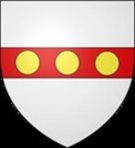
D'Aubigny coat of arms
As overlords, the D’Aubigny barony leased Tingrith Manor to the Pinkney family as intermediary lords, owing fealty to the barony. The manor was later shown attached to Pinkney’s manor of Datchet [Berkshire] and remained so until at least 1614 when Lord Moleyns was Lord of the Manor of Datchet and thus intermediary lord of Tingrith Manor.
Around 1231, Robert de Pinkney granted Tingrith Manor to his grandson Walter de Daventry, whose father Simon had married Robert’s daughter, Isabella. Walter’s name was originally Walter FitzSimon, following Norman tradition of creating surnames for nobles who held no land by adding Fitz to the father’s name, but on holding the manor of Daventry, Walter became entitled to call himself Walter de Daventry after his principal seat. Daintry Wood, to the west of Tingrith, is probably a corruption of the name Daventry Wood.
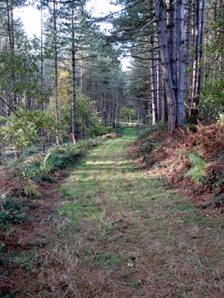 Daintry Wood
Daintry Wood
An inquisition held at Cainhoe in 1264 confirmed that Robert, son of Walter of Daventry, held 2 fees in Tingrith, granted by Henry de Pynckney, who in turn held the land from William D’Aubigny who held half the barony of Cainhoe. Relations between the barony and the intermediary lords were not however without problems. In 1303, Walter’s grandson Walter was taken to court by Joan, William D’Aubigny’s daughter, and her husband Ammory de Nowers for:
‘arrears of releifs, escuage & defaults of court in their manor of Cainhoe for 2 1/2 knight's fees in Tingrith, & Husborne Crawley, held of sd. manor of Cainhoe’
Robert countered with complaints against Amory and Joan ‘of various trespasses’ but still had to pay Amory and Joan off.
Walter’s descendants held the intermediary lordship of Tingrith Manor until 1387 when the last of the male line, Thomas de Daventry, died without a surviving son. His two sisters became co-heirs and the manor was split. Matilda received half the manor, known as Tingrith Manor. She had married Thomas Curtis, a Cornish MP and landowner, and she rented her half or moiety of the manor to her sister Joan who had received the other moiety, known as Walweyns Manor after Joan’s husband Philip de Walweyn.
Although the de Pinkneys were intermediary lords of the manor, the owners of the advowson of Tingrith give more clues to the actual lords of the manor. Patronage of the Rectors passed from Robert Dykeswell of Tingrith’s other manor, Dixwell’s, to Thomas Peyvr, then Lord of Toddington Manor, and then in 1424 to John Brokkele, named as Lord of the Manor of Tingrith. John Brokkele was a master draper of London, an alderman and was elected Mayor of London in 1433. His widow still held the advowson for Tingrith in 1445.

The Broughton family arms
The advowson was then taken over by John Broughton, who had married into the Peyver family of Toddington, and was named as late Lord of the Manor of Tingrith in the list of Rectors.In 1489 this former Sheriff of Bedfordshire left Tingrith Manor in his will to his grandson Robert. Robert Broughton was a landowner, an MP for Suffolk and a soldier who was knighted on the battlefield at the Battle of Stoke in 1487, the very last battle in the Wars of the Roses, where he fought on the winning Lancastrian side. Through his wife he was uncle to Jane Seymour, the third wife of Henry Vlll (1509-1547).
In 1540 Tingrith Manor passed from the Broughtons to Sir Thomas Cheney, an administrator and diplomat, who had married Robert Broughton’s granddaughter, Anne. Like Richard de Grey, overlord of Dixwells Manor if not Tingrith Manor as well, Cheney had been present at the Field of the Cloth of Gold with Henry Vlll. Although a Catholic, Sir Thomas was a favourite of Anne Boleyn and he must have been a very wily politician serving all five Tudor monarchs, both Catholic and Protestant, without losing his head. He held a variety of influential offices including Warden of the Cinque Ports.
The Manor remained with the Cheneys until 1614 when Thomas Wentworth, who later became 1st Earl of Cleveland, inherited the Toddington estate from a Cheney aunt. Thomas Wentworth was a Royalist cavalier general who fought for Charles l (1625-1649) during the English Civil War. He was said to be a “man of signal courage and an excellent officer” whose bravery and presence of mind assisted Charles ll (1660-1685) to escape from the aftermath of the Battle of Worcester in 1650. Unfortunately, Thomas was not so lucky. He was captured and imprisoned in the Tower of London for five years.
Early extravagance and the fortunes of war had greatly reduced his estates and in 1641 an Act of Parliament authorised the sale of the Earl of Cleveland’s estates to satisfy his creditors. Some land in Tingrith was sold to William Ashton, the owner of Dixwell’s Manor, some to Henry Brandreth of Houghton Regis, who promptly sold it again, and Tingrith Manor itself eventually became the property of the Chernock family of Hulcote.
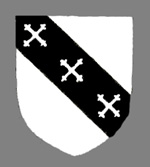
Chernock family arms
By 1705 Tingrith Manor belonged to Sir Pynsent Chernock. Sir Pynsent may have inherited the manor from his father Sir Villiers Chernock or through his wife, Dame Helen, the daughter of Sir William Boteler of Biddenham. In 1672 the Court Roll was held in the name of William Mole, whose father is buried in front of the altar in Tingrith Church. The memorial stone states William was married to the second daughter of Sir William Boteler and it is clear that the Boteler family must have owned land of some importance in Tingrith as Sir William’s heirs were listed as having to contribute to the Poor Rate in 1705. Helen and Anne were both co-heirs of their father and possibly they inherited Tingrith Manor from him.
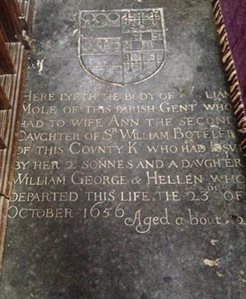
Tombstone of William Mole in the church
Both Sir Pynsent’s father, Sir Villiers Chernock, and his father in law, Sir William Boteler, were Tory MP’s fighting in Bedfordshire against the Whigs and their supporters the Dukes of Bedford, so it was natural that Sir Pynsent would become a Tory MP and he entered parliament in 1705. He finally lost his seat in 1715 to Edward Russell, the Duke of Bedford’s uncle and was forced to mortgage and eventually to sell Tingrith Manor to fund his election campaigns. The Duke of Bedford recorded that Sir Pynsent was forced to make the sale "having been always too honest and upright while in Parliament to sacrifice the liberties of his country for a place or pension". In 1730 he sold the manor to David Willaume.
David Willaume was a French Huguenot goldsmith and banker from London looking for somewhere to retire. Like many Huguenots no longer allowed to practise their Protestant religion following the Edict of Nantes in 1685, he left France for England. With premises in Mayfair he became one of the emerging class of ‘gentlemen’ goldsmith bankers during the late 17th and early 18th centuries. Wanting a country estate of his own he bought Tingrith Manor and when he died in1741 he was buried at Saint Nicholas's Church. In his will he left £105 to be divided between his daughter, son-in-law (David Tanqueray), and the poor of Saint Martin-in-the-Fields [Middlesex], with all the unquantified goods and chattels and remainder of the estate passing to his son.
The younger David Willaume (1693–1761) took over the family business in about 1728, when he entered his own hallmarks as a gold and silversmith. In 1733, already a widower, he married Elizabeth, daughter of attorney Charles Dymoke of Ampthill and was appointed High Sheriff of Bedfordshire in 1737. Both David Willaume and his second wife were buried in Tingrith.
On the death of his father in 1761 not only did David’s son Edward Willaume become Lord of the Manor, but he also inherited the advowson for the parish of Tingrith. Around 1775, Edward bought Dixwell’s Manor, combining the two manors of Tingrith, and when Thomas Tanqueray, Tingrith’s Rector and also his cousin, died in 1783, Edward became himself Rector of Tingrith, having previously been curate. He remained Rector of the parish until his death in 1788. The monument to Edward Willaume in Saint Nicholas Church erected by “His afflicted Widow” describes him as “a kind, tender, and indulgent Husband” and says his death was “sincerely and justly regretted by all who knew him”.

Monument to Edward Willaume in the church
In 1790 Essex Willaume, Edward’s widow, is referred to as the lady of the Manors of Tingrith and Dixwell’s, when a Court Leet was advertised to be held at the Manor House Tingrith. The Court Leet was held on her behalf so that her steward, John Rotherham, could collect rents and arrears.
On the death of Edward’s widow, his brother Charles Dymoke Willaume, held the Manor as tenant for life from his younger brother John Williams Willaume who had taken over management of the estate on Edward’s death. John was very interested in new methods of farming in farming and in 1803 he was nominated as Sheriff of Bedfordshire. However by 1806 he had left Tingrith and moved to Grosvenor Square, London. He died in 1810 but just before his death he sold the Tingrith estate to Robert Trevor.
Robert Trevor, the great grandson of Baron Trevor of Bromham, inherited wealth and property from his mother’s cousin, Earl Hampden, who died childless. He and his wife Mary had rented Flitwick Manor before buying Tingrith Manor where he lived the life of a Regency country gentleman.
Although Robert owned many farms, having estates in Little Hampden and Chellington as well as Tingrith, he was very much a ‘gentleman farmer’ relying on his steward and his brother in law (the vicar of Carlton) for advice and practical help. He did however act as a magistrate for many years, and commanded the Ampthill Troop of Yeomanry, to ‘serve as required’.
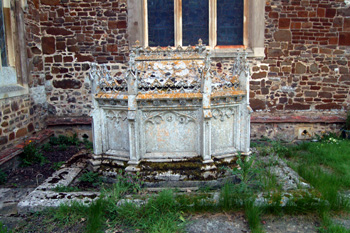
Tomb of Robert Trevor on the south side of Tingrith church April 2009
Robert and Mary had three daughters each of whom inherited a third of the manor when Robert died in 1834. None of the girls married. Mary, Elizabeth and Catherine Trevor, the Misses Trevor, were talented, intelligent women who lived up to their strong Christian faith and worked hard to support their tenants. They restored the Church, which had bricked up windows and walls green with mould, to their own design; they extended the gardens of TIngrith House which were used for village fetes and cricket matches as well as for their own pleasure, they built the school and funded its running and they built a Club Room to be used for meetings, readings and entertainment. In the 1860s when work for agricultural workers was hard to find, they also paid for 112 villagers, half the population of the village, to emigrate to Canada, at that time an innovative and no doubt frightening venture.
Elizabeth died in 1866 followed five years later by Catherine. Mary survived another twelve years. The Misses Trevor were buried with their parents in the family vault next to the Church porch.
On Mary’s death in 1883, Tingrith Manor, together with the manor of Little Hampden also owned by the Trevors, passed to the Trevor’s kinsman William Wilberforce Battye, Rector of Hever [Kent]. In 1890 Rev. Battye's widow assumed the name of Trevor in addition to that of Battye by royal licence, when their son Captain Charles E. Trevor-Battye, who had served in the Zulu war, became Lord of Tingrith Manor. As the Trevor-Battyes had homes elsewhere and Charles was in South Africa, Tingrith Manor was rented out.
In 1885, Admiral Mark Pechell leased Tingrith House for his family, having previously leased Caddington Hall. Coming from an illustrious naval family, he had entered the navy at the age of 13 and served as a Lieutenant Commander of a gun boat in the Baltic Expedition of 1854-55, when an Anglo-French fleet entered the Baltic Sea to attack the Russian naval base of Kronstadt during the Crimean War. Although not ‘Lord of the Manor’, whilst living at Tingrith House Admiral Pechell took on the duties of the leading family of the village, acting as a J.P. for Bedfordshire, vice-president of the Beds Dairy Farmers Association, giving a village tea and firework display when his daughter married and becoming a manager of the school. In 1887 a concert was held in the village Club Room to raise funds for the schoolchildren. According to newspaper reports, the platform was ‘tastefully decorated’; with plants from Tingrith Manor courtesy of Mrs Pechell, and Miss C. Pechell ‘bids fair to become a talented violinist’, which sounds rather a back handed compliment. In the same year the first fox hunting meet for nearly 50 years was held at the Manor. The Pechells had nine children but after they left Tingrith they lost their two eldest sons a few days apart in 1899 in the second Boer War, one being killed in at Glencoe and the other mortally wounded at the Siege of Mafeking. Their third son was one of the survivors at Mafeking.
By 1894 Tingrith House, was leased to Hanbury Barclay, a retired Colonel of the 1st Volunteer Battalion, South Staffordshire Regiment. The Barclay family took a very active part in local and county society. They were popular members of the village and although Colonel Barclay moved back to London in 1902, on his death in 1909 he was brought back to Tingrith to be buried with his wife and son who had both died at Tingrith Manor.
Capt Trevor-Battye and his new South African wife moved into the Manor in 1902 and they carried out their duties towards the village with generosity. On Christmas Day they continued the tradition of entertaining the women and children of the village to a tea and Christmas tree with presents in the afternoon, with the men to be entertained later, presumably when they had finished work. To celebrate the arrival of Capt.Trevor-Battye’s son and heir, Hugo, at the Manor in 1904 a large marquee was erected in front of the House and the whole village sat down to an ‘excellent spread’. Sports were held with ‘handsome prizes’, there was music in the afternoon and dancing in the evening to a Quadrille Band from Luton and the celebrations finished with a firework display.
In 1907 the Captain cut the first sod of Toddington Rifle Range of which he was president for several years. By 1911 the Trevor-Battyes had moved to their other estate in Little Hampden and once again Tingrith Manor was put up for rent.
This time the Manor and shooting rights were leased to City shipping, transport and banking tycoon, Mr C J Cater Scott, chairman of the London and India Docks Company and many other companies. As expected of a man in his position he took over the role of Lord of the Manor, funding church choir outings, lending his car for transport and providing entertainments at the village Club Room. He held a fete at Tingrith House in aid of the Primrose League, an organisation for spreading Conservative principles, with sporting events, including bowling, which still takes place at Tingrith’s annual fete today. Captain Trevor-Battye, still Lord of Tingrith Manor, visited Tingrith in 1914 to preside over a public meeting to stimulate recruitment for the Great War and in the same year Mr Cater Scott housed 10 convalescent soldiers at the Manor and he also invited soldiers convalescing at Wrest Park to Tingrith to tea. He was a supporter of village cricket and was made a vice-president of Bedfordshire Cricket Club. In 1915 he invited the Westoning team to the Manor to play against the soldiers convalescing there. In December 1915 his wife died having endeared herself to villagers and their children with her ‘sympathy and kindness’. Mr Cater Scott stayed in the village continuing traditions such as dressing up himself as Father Christmas to give the children of the village their presents.
Captain Trevor-Battye served in Flanders but after the War he resigned his commission on the grounds of ill health and in 1919 he sold the entire Tingrith estate. Mr Cater Scott left the village but was buried next to his wife to the left of the Church porch when he died in 1931.
The estate was sold to Mr Stewart Hubbard of Luton, a wealthy Luton businessman, making his money from the hat industry for which Luton was famous. He had the house completely renovated by Mr W. J. Sharpe, a builder from Ampthill and when trying to claim compensation for the diminution in value of the estate after the erection of four electricity pylons he said he had bought the estate because it was close to his business and the whole estate was like a garden with all the villagers being employed directly or indirectly on the estate. The estate was very good for game with a very high density of birds. Mr Hubbard was the last Lord of Tingrith Manor.
By the 1920s a succession of Law of Property Acts had effectively abolished manors in all but name, so Tingrith no longer had a ’Lord of the Manor’, and in 1925 The Rating and Valuation Act specified that every building and piece of land in the country was to be assessed to determine its rateable value. The valuer visiting Tingrith House found it ‘owned and occupied by S Hubbard, who owned most of the properties in the village’ [DV1/C240/3744]. The property stood in 8.584 acres.
Downstairs accommodation comprised: a porch; a hall measuring 17 feet 6 inches by 10 feet 6 inches and 10 feet by 15 feet; a drawing room measuring 20 feet by 28 feet with a bay measuring 10 feet by 4 feet and a bay measuring 11 feet 6 inches by 2 feet; a study measuring 20 feet square with a bay measuring 14 feet by 4 feet; a cupboard under the stairs; a dining room measuring 23 feet by 18 feet 3 inches; a glazed roof lounge measuring 7 feet by 35 feet leading to a billiard room measuring 34 feet by 18 feet; a WC and wash basin; Mr Hubbard junior’s study measuring 20 feet by 17 feet “now return through Billiard Room and Glazed lounge” – WC; servants’ hall measuring 13 feet by 18 feet; larder and store room (“large and good”); kitchen measuring 17 feet by 20 feet 6 inches; scullery; larder; larder; butler’s pantry; door leading to cellars - “past back stairs and through door leading to hall” – telephone room.
On the first floor were seven bedrooms measuring, respectively: 20 feet square with a bay 14 feet by 4 feet; 18 feet by 15 feet; 15 feet by 14 feet; 15 feet by 18 feet 6 inches; 20 feet by 12 feet; 10 feet by 12 feet and 9 feet by 16 feet 6 inches; a dressing room; three bathrooms; a line cupboard; a housemaid’s cupboard and a WC. There were three servants’ bedrooms, each with two beds, a servants’ bathroom and a box room. The other side of the back stairs were: a boudoir measuring 16 feet by 10 feet 6 inches with a 9 feet by 2 feet 6 inches bay; a bedroom measuring 17 feet by 19 feet and a 10 feet by 2 feet 6 inches bay and a cupboard.
The valuer commented: “House lighted by electric light. Central heating. Radiators in corridor upstairs and most principal bedrooms. Tiled fireplaces. Generally in very good order”.
Outside was a heated conservatory measuring 42 feet by 23 feet. On the west side of the house was a range of cement-faced and slate store sheds and coal sheds, an engine house with a switchboard and old three horsepower engine, a range of cement-faced and slate stalls and loose boxes with a loft over, a harness room, a garage for two cars with an inspection pit, a semi-covered washing yard, a coachhouse and one-stall loose box, a wood and corrugated iron lean-to trap house, a covered cleaning pit, a range of three pigsties, a brick and slate tool shed and brick, wood and corrugated iron potting shed.
In the garden yard was a three-quarter span heated greenhouse measuring 30 feet by 12 feet, two rows of cold frames measuring 36 feet by 8 feet, a wood and slate stoke hole, a three-bay open shed and a range of wood and tiled store sheds. In the kitchen garden was a heated greenhouse measuring 72 feet by 14 feet and a heated lean-to glasshouse measuring 40 feet by 12 feet 6 inches.
In 1932 Mr and Mrs Hubbard moved to Wrest Lodge Silsoe and what was left of the estate was sold. On 10th August the auctioneer, Mr. Farrer, said that it was only with great reluctance that Mr and Mrs Hubbard had left the village and all would agree that while Mr. and Mrs. Hubbard were in the village they did everything possible for the estate. They certainly seemed to have been generous to individual villagers giving one young couple a willow pattern dinner service when they married and giving practical presents such as small chairs to village children at Christmas.
Tingrith House was bought by Mrs Lettice Lambton, the wife of Hon. Claud Lambton, the son of the 2nd Earl of Durham. They sold their house in Lancaster Gate and moved to Tingrith with their four children.
Their eldest son Hedworth was a Commander in the Royal Navy, coming out of retirement in World War ll, and was awarded the DSC when his sloop HMS Lark sank a U-boat in the Barents Sea near Murmansk, Russia. Their second son D’Arcy was tragically killed in a car accident near Oxford in 1938. D’Arcy’s wife Monica was seriously injured but recovered and is buried with D’Arcy, Claud and Lettice in Tingrith churchyard.
Their third and youngest son Gervase managed the Tingrith estate for his father and had his own small menagerie of animals, some of which were used for animal rides at the village fete. He published a book, Animal Lover, in 1936 saying that animals were “the great joy of my life”. Tragically, on his way to look at a coffee plantation in Kenya, he was lost overboard in the Red Sea in 1937 and there is a plaque to his memory in the bus shelter in the centre of Tingrith. Claud and Lettice died within a month of each other at the beginning of 1945.
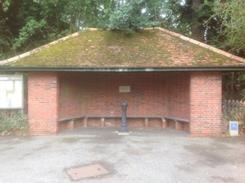
Tingrith bus shelter
The Manor was again for sale and there seem to be more than one family living there in the late 1940’s. In 1946 Major V Kelaart occupied the main part of the house with his wife Aura and son Paul, and the two wings of the house were let out to other tenants. Mrs Kelaart won prizes at county and local shows with her horses and flowers but didn’t have as much luck with her driving, being fined £1 in 1950 for obstructing a footpath with her shooting brake. She was quoted in the local paper as saying the arresting officer was “Much too young to be a policeman”. Major Kelaart also faced a speeding fine of 10 shillings in 1948. Major Kelaart was President of the local branch of the Conservative Association and carried on the tradition of providing a Christmas tree for the village children. Indeed he endeavoured to move further into horticulture, growing flowers for sale at Covent Garden and employing girls from the village to pick and pack them.
Mrs. Gwynne made her home in one of the wings of the Manor and is remembered as an industrious President of Tingrith Women’s Institute, organising numerous activities at the Village Hall and was even known to hold a whist drive in her own room at the Manor, raising the sum of £7 11s. 6d. for the W.I. Outing Fund in 1948. Another resident of the Manor and member of Tingrith W.I., Miss Evelyn G Priestley, invited members of the Young Conservative Movement to visit her there in 1946, where they spent ‘an enjoyable time’.
In 1953 Tingrith Manor, ‘a manor house with 180 acres’, was sold privately to John Tillotson from Bolton [Lancashire] whose family owned Tillotson Newspapers now known as the The Bolton News.
It was originally planned that the M1 would run through the Manor grounds but objections from 31 villagers published in The Times in 1955 resulted in it being rerouted ‘away ‘from the village. Obviously not far enough away: the Manor was demolished in the late 50s. The houses of Saint Nicholas Close were built upon the site.